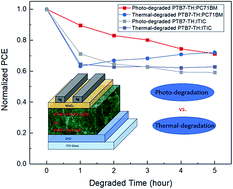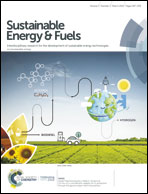Comparative study of light- and thermal-induced degradation for both fullerene and non-fullerene-based organic solar cells†
Abstract
Solution-processed organic solar cells (OSCs) have become a promising renewable energy technology in recent years. The fast initial degradation, which causes performance reduction at the initial stage for OSCs, needs to be understood and investigated thoroughly. In this work, for the first time, we have conducted a comparative study of light- and thermal-induced degradation during the burn-in process. As revealed in the estimation of Urbach energy, both light and thermal degradation created an increased energetic disorder. However, characterisation by steady-state photoluminescence (PL), time-resolved photoluminescence (TRPL) and capacitance–voltage (C–V) indicates that the mechanisms behind these two types of degradation are very different. The loss in light degradation was found to be more related to its degraded energy transfer ability, exciton dissociation ability and increased non-radiative recombination; whereas, the loss in thermal degradation was found to be more related to the reduced current extraction ability and increased leakage current.



 Please wait while we load your content...
Please wait while we load your content...